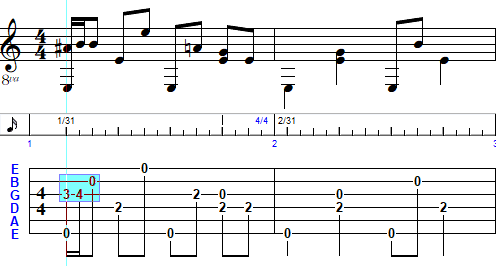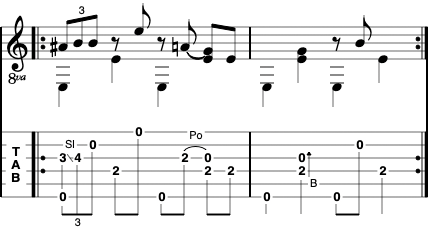Basic Tablature Entry
Watch the video on YouTube
Let's assume that you want to enter the first two measures of "l'Echo des Savanes" (a tune by the late, lamented Marcel Dadi) into TablEdit.

The first thing to remember in TablEdit is that notes have to be entered at the correct location within the tablature grid. Simply move the cursor, using either the cursor [![]() ,
,![]() ,
,![]() ,
,![]() ] keys or by clicking with the mouse and then enter the desired number from the keyboard (to enter a rest, use a period/full stop [.]). In an alternating bass piece, such as this one, it may be more convenient to start by placing the bass notes ("0" and "2") on the four beats of the measure before entering the melody line.
] keys or by clicking with the mouse and then enter the desired number from the keyboard (to enter a rest, use a period/full stop [.]). In an alternating bass piece, such as this one, it may be more convenient to start by placing the bass notes ("0" and "2") on the four beats of the measure before entering the melody line.
When you're first starting out, it can be a good idea to use the "Automatic duration" function (click on the "X" at the far left of the "Notes" palette). In this mode, the notes you enter are automatically assigned a logical duration in relation to their position and environment. Now the far left button doesn't show a static "X" but dynamically displays the automatic duration of the note that would be inserted.
In the example below, when you enter the "3" on the 3rd string it will be displayed as a whole note. But, when you enter the following "4" the "3" is transformed into a 1/16th note and the "4" is displayed as a dotted 1/8th note. The "4" won't convert itself into a 1/16th note until you enter the "0" on the 2nd string.

Once this has been done, you have to select the notes whose durations you wish to modify or to which you wish to apply a special effect.
First, create a block by clicking on the "3" of the 3rd string and, keeping the left mouse button held down, dragging the mouse pointer to the right and upwards until the block includes all three of the notes you've just entered. Now, go down to the Notes palette and click on the button representing an 1/8th note and then on the one containing the number "3". The three selected notes will now be converted into an 1/8th note triplet.
The bass notes, however, are still displayed as 1/16th notes (I hear you cry). To convert them into the required 1/4 notes, place the cursor on the first bass note and de-select the triplet option in the "Notes" palette then click on the button representing a 1/4 note. While 1/4 notes are still selected as the current duration, convert the "2" of the second beat, and the "0" of the third into 1/4 notes by pressing [*].
If you apply the same procedure to the "2" on the 4th beat, TablEdit will display the note in red, indicating a duration error. In fact, this note cannot be a 1/4 note in length since it gets cut off by the "2" which follows it. In order to correct this, just select the incorrect note and press [J]. This will convert it back into an 1/8th note.
Entering special effect is easy as pie. All you have to do is select the note or notes to be modified and then open {Note | Special Effects} or click on the desired effect in the Special Effects palette.
Here's a preview of the result you'll get when printing out the page. If the standard notation doesn't print out the way it looks here it probably means that the Tef265_2.ttf font isn't correctly installed on your system.

To enter repeat signs, Da signo markings, Codas, etc. as other than simple TablEdit Tutorial for MacOS - Basic Entry graphical symbols, you have to use the "Reading list" function in {MIDI | Reading list} to define two sequences (1>2) and (1>2). This kills two birds with one stone. You tell TablEdit that the measure should be repeated twice and you cause the corresponding repeat markings to be displayed.
In order to obtain a faithful musical reproduction all that's left for you to do is to set the "Picking syncopation" to a value of "2" and the tempo to 160. Both of these settings are made in the {MIDI | MIDI options}.
Naturally, TablEdit affords you many other possibilities but to go into all of them here would go way beyond the intention of this section whose sole objective has been to present the basic mechanisms of the program by direct example.
See also: http://el-kay.com/tabledit/en/EnteringNotes-2.htm